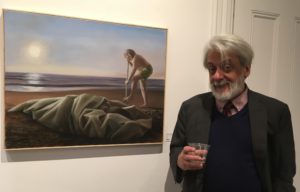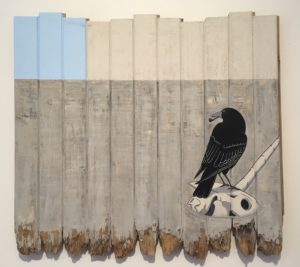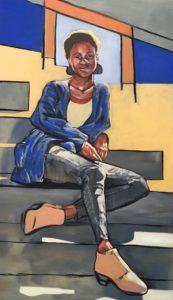Small, local art shows have become an inadvertant theme for the Massachusetts Medievalist this month. I’ve always inclined toward larger, established institutions when seeking out art; I get to the MFA and the Harvard Art Museums pretty regularly. Three small art shows in Cambridge this March have me rethinking that strategy, however, as I’ve found that I enjoy thinking deeply about fewer pieces seen in a shorter period of time.
Anthony Apesos, my erstwhile co-conspirator for an interdisciplinary class on Milton’s Paradise Lost, features in a show at the Cambridge Art Association; all of Tony’s paintings are “illustrations” of Greek myths, but the moments he chooses to depict are not the typical epitomic moments of those narratives. For example, in “Dedalus and Icarus” (below, with the artist), the illustration is set in a contemporary landscape; Dedalus digs a grave in the sand for the body of his dead son. Perhaps assisted by the presence of a nice white wine, I spent a long time looking at this image, much longer than I would have in a larger exhibition context. Dedalus’s modern shorts contrast with the timelessness of Icarus’s plain shroud, and Tony forces the viewer to look at the exposed face of the dead boy, to imagine the grief of the isolated father digging the grave.

Right around the corner from my office, Maud Morgan Arts provides exhibit space for local artists. Renaissance man Bill Porter works in the academic technology department at Lesley; he also teaches animation and makes very cool paintings. I popped into his show “Impact” as part of an extended lunch break on a Friday afternoon and was immediately taken by his use of nontraditional items as “canvases” for his paintings. He uses old shingles, boards, and even bits of fences, as in “Clearing Skies,” with the whimsical but unsettling unicorn/narwhal skull as the perch for the pipe-smoking raven. The fence injected a note of reality into the otherwise almost absurdist image.

Finally, two Lesley students have installed a specatcular series of portraits of African-American women in the atrium of our university library. “Portraits and Power” by Mosheh Tucker and Rocky Cotard presents larger-than-life images of women in the artists’s communities. Tucker works on traditional canvas, while Cotard’s pieces use loose fabric hung on rails, evoking the femininity implied in cloth and cloth making. Tucker’s “Ms. Marcel” (below) plays with geometry and space in the background of this full-length portrait in an almost Escher-like way; I also really enjoyed the ways that the colors of the figure’s clothes and skin interact with those of the background.

I’m realizing as well that all of these shows are associated with Lesley University, so I’m suddenly feeling a warm regard for my university as an art-supporting venue in the community. As spring semester progresses, I’ll be looking for more small art shows to explore.
